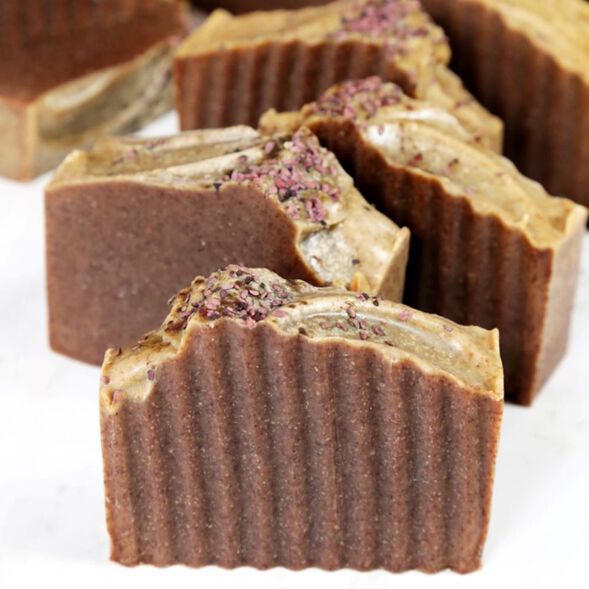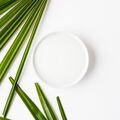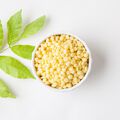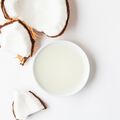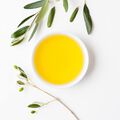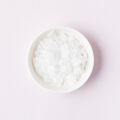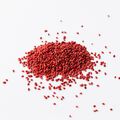
Beet Soap Project
- Skill Level: Beginner
- Time: 1 hour
- Yield: 2-3 pounds of soap
Project Description
We love testing new ingredients. Beet root powder and rosehip powder are two additives that have interesting results in cold process soap. Despite its vibrant natural color, beet root powder fades almost completely in cold process soap. However, it’s full of vitamins, magnesium, and folate.
On the other hand, rosehip powder goes through an interesting color transformation. Its bright yellow color remains when added to cold process soap. Once the soap is unmolded and cut into bars, that’s when things get interesting. Immediately after cutting into the soap, you’ll notice a burgundy color around the bars (shown below). Within about 10 minutes, this color makes its way throughout the entire bar of soap and deepens over 2-3 days.
Rosehip powder does color the lather a bit, and you will find that with these bars. If you’re worried about color transfer, you can use 1 teaspoon of powder. Just keep in mind you will have a lighter color.
You will need:
- 10″ Silicone Loaf Mold
- 1.7 oz. Babassu Oil (5%)
- 3.3 oz. Cocoa Butter (10%)
- 8.3 oz. Coconut Oil (25%)
- 19.8 oz. Olive Oil (60%)
- 4.6 oz. Sodium Hydroxide Lye
- 10.9 oz. Distilled Water
- 1.75 oz. Lavender 40/42 Essential Oil
- 11.2 oz. Distilled Water (15% water discount)
- 1 Tbsp. Beet Root Powder
- 2 tsp. Rosehip Powder
- Cranberry Seeds
COLOR PREP: Measure out 1 tablespoon of beet powder and 2 teaspoons of rosehip powder into a small container (or two separate containers). Set them aside.
FRAGRANCE PREP: Measure 1.75 ounces of Lavender 40/42 Essential Oil into a small glass container and set aside.
SAFETY FIRST: Suit up for safe handling practices. That means goggles, gloves, and long sleeves. Make sure kids, pets, other distractions, and tripping hazards are out of the house or don’t have access to your soaping space. Always soap in a well-ventilated area.
Follow these steps:
1
Slowly and carefully add 4.6 ounces of lye to 10.9 ounces of water and gently stir until the lye has fully dissolved and the liquid is clear. Set aside to cool. If you’d like a harder bar of soap that releases faster from the mold, you can add sodium lactate to the cooled lye water. Use 1 teaspoon of sodium lactate per pound of oils in the recipe. For this recipe, you’d add 2 teaspoons sodium lactate.
2
Melt and combine 8.3 ounces of coconut oil, 1.7 ounces of babassu oil, 3.3 ounces of cocoa butter, and 19.8 ounces of olive oil in a large bowl. Add the measured beet root powder and rosehip powder directly into the oils and use the stick blender to fully mix them in.
3
Once the lye water and the oils have cooled to 130° F or below (and are ideally within 10 degrees of each other), add the lye water to the oils and stick blend until thin trace.
4
Add 1.75 ounces of Lavender 40/42/Essential Oil to the soap. Use the stick blender to fully incorporate.
5
Continue stick blending the soap batter until you reach a medium to thick trace. This may take a few minutes of blending.
6
Once you’ve reached the texture of thick pudding, pour all of the soap into the mold. Tap it firmly on the counter to help get rid of air bubbles.
7
Use a spoon to create texture on top of the soap. We pushed the soap to one side to create a wave-like effect. If you find the soap is not holding its shape, allow it to sit in the mold for a few minutes to thicken and harden. Then, try creating texture on top again.
8
Once you’re happy with the top, sprinkle beet root powder and cranberry seeds on the top. We concentrated the seeds and powder on the peak of the soap.
9
Spritz the top of the soap with 99% isopropyl alcohol to prevent soda ash. We put this soap in a drawer in a room temperature area to lightly insulate without disrupting the textured top.
Allow the soap to stay in the mold for 2-3 days. Pull the sides away from the mold to release the airlock and push the soap out from the bottom. If the mold does not pull away from the soap easily, give it another day or two in the mold. Once removed, cut into bars and allow to cure for 4-6 weeks. Enjoy.
Tutorial credits
Photographer: Amanda Kerzman

Beet Soap Project
- Skill Level: Beginner
- Time: 1 hour
- Yield: 2-3 pounds of soap
Project Description
We love testing new ingredients. Beet root powder and rosehip powder are two additives that have interesting results in cold process soap. Despite its vibrant natural color, beet root powder fades almost completely in cold process soap. However, it’s full of vitamins, magnesium, and folate.
On the other hand, rosehip powder goes through an interesting color transformation. Its bright yellow color remains when added to cold process soap. Once the soap is unmolded and cut into bars, that’s when things get interesting. Immediately after cutting into the soap, you’ll notice a burgundy color around the bars (shown below). Within about 10 minutes, this color makes its way throughout the entire bar of soap and deepens over 2-3 days.
Rosehip powder does color the lather a bit, and you will find that with these bars. If you’re worried about color transfer, you can use 1 teaspoon of powder. Just keep in mind you will have a lighter color.
You will need:
- 10″ Silicone Loaf Mold
- 1.7 oz. Babassu Oil (5%)
- 3.3 oz. Cocoa Butter (10%)
- 8.3 oz. Coconut Oil (25%)
- 19.8 oz. Olive Oil (60%)
- 4.6 oz. Sodium Hydroxide Lye
- 10.9 oz. Distilled Water
- 1.75 oz. Lavender 40/42 Essential Oil
- 11.2 oz. Distilled Water (15% water discount)
- 1 Tbsp. Beet Root Powder
- 2 tsp. Rosehip Powder
- Cranberry Seeds
COLOR PREP: Measure out 1 tablespoon of beet powder and 2 teaspoons of rosehip powder into a small container (or two separate containers). Set them aside.
FRAGRANCE PREP: Measure 1.75 ounces of Lavender 40/42 Essential Oil into a small glass container and set aside.
SAFETY FIRST: Suit up for safe handling practices. That means goggles, gloves, and long sleeves. Make sure kids, pets, other distractions, and tripping hazards are out of the house or don’t have access to your soaping space. Always soap in a well-ventilated area.
Follow these steps:
1
Slowly and carefully add 4.6 ounces of lye to 10.9 ounces of water and gently stir until the lye has fully dissolved and the liquid is clear. Set aside to cool. If you’d like a harder bar of soap that releases faster from the mold, you can add sodium lactate to the cooled lye water. Use 1 teaspoon of sodium lactate per pound of oils in the recipe. For this recipe, you’d add 2 teaspoons sodium lactate.
2
Melt and combine 8.3 ounces of coconut oil, 1.7 ounces of babassu oil, 3.3 ounces of cocoa butter, and 19.8 ounces of olive oil in a large bowl. Add the measured beet root powder and rosehip powder directly into the oils and use the stick blender to fully mix them in.
3
Once the lye water and the oils have cooled to 130° F or below (and are ideally within 10 degrees of each other), add the lye water to the oils and stick blend until thin trace.
4
Add 1.75 ounces of Lavender 40/42/Essential Oil to the soap. Use the stick blender to fully incorporate.
5
Continue stick blending the soap batter until you reach a medium to thick trace. This may take a few minutes of blending.
6
Once you’ve reached the texture of thick pudding, pour all of the soap into the mold. Tap it firmly on the counter to help get rid of air bubbles.
7
Use a spoon to create texture on top of the soap. We pushed the soap to one side to create a wave-like effect. If you find the soap is not holding its shape, allow it to sit in the mold for a few minutes to thicken and harden. Then, try creating texture on top again.
8
Once you’re happy with the top, sprinkle beet root powder and cranberry seeds on the top. We concentrated the seeds and powder on the peak of the soap.
9
Spritz the top of the soap with 99% isopropyl alcohol to prevent soda ash. We put this soap in a drawer in a room temperature area to lightly insulate without disrupting the textured top.
Allow the soap to stay in the mold for 2-3 days. Pull the sides away from the mold to release the airlock and push the soap out from the bottom. If the mold does not pull away from the soap easily, give it another day or two in the mold. Once removed, cut into bars and allow to cure for 4-6 weeks. Enjoy.
Tutorial credits
Photographer: Amanda Kerzman
You will need:
- 10″ Silicone Loaf Mold
- 1.7 oz. Babassu Oil (5%)
- 3.3 oz. Cocoa Butter (10%)
- 8.3 oz. Coconut Oil (25%)
- 19.8 oz. Olive Oil (60%)
- 4.6 oz. Sodium Hydroxide Lye
- 10.9 oz. Distilled Water
- 1.75 oz. Lavender 40/42 Essential Oil
- 11.2 oz. Distilled Water (15% water discount)
- 1 Tbsp. Beet Root Powder
- 2 tsp. Rosehip Powder
- Cranberry Seeds
COLOR PREP: Measure out 1 tablespoon of beet powder and 2 teaspoons of rosehip powder into a small container (or two separate containers). Set them aside.
FRAGRANCE PREP: Measure 1.75 ounces of Lavender 40/42 Essential Oil into a small glass container and set aside.
SAFETY FIRST: Suit up for safe handling practices. That means goggles, gloves, and long sleeves. Make sure kids, pets, other distractions, and tripping hazards are out of the house or don’t have access to your soaping space. Always soap in a well-ventilated area.
Follow these steps:
1
Slowly and carefully add 4.6 ounces of lye to 10.9 ounces of water and gently stir until the lye has fully dissolved and the liquid is clear. Set aside to cool. If you’d like a harder bar of soap that releases faster from the mold, you can add sodium lactate to the cooled lye water. Use 1 teaspoon of sodium lactate per pound of oils in the recipe. For this recipe, you’d add 2 teaspoons sodium lactate.
2
Melt and combine 8.3 ounces of coconut oil, 1.7 ounces of babassu oil, 3.3 ounces of cocoa butter, and 19.8 ounces of olive oil in a large bowl. Add the measured beet root powder and rosehip powder directly into the oils and use the stick blender to fully mix them in.
3
Once the lye water and the oils have cooled to 130° F or below (and are ideally within 10 degrees of each other), add the lye water to the oils and stick blend until thin trace.
4
Add 1.75 ounces of Lavender 40/42/Essential Oil to the soap. Use the stick blender to fully incorporate.
5
Continue stick blending the soap batter until you reach a medium to thick trace. This may take a few minutes of blending.
6
Once you’ve reached the texture of thick pudding, pour all of the soap into the mold. Tap it firmly on the counter to help get rid of air bubbles.
7
Use a spoon to create texture on top of the soap. We pushed the soap to one side to create a wave-like effect. If you find the soap is not holding its shape, allow it to sit in the mold for a few minutes to thicken and harden. Then, try creating texture on top again.
8
Once you’re happy with the top, sprinkle beet root powder and cranberry seeds on the top. We concentrated the seeds and powder on the peak of the soap.
9
Spritz the top of the soap with 99% isopropyl alcohol to prevent soda ash. We put this soap in a drawer in a room temperature area to lightly insulate without disrupting the textured top.
Allow the soap to stay in the mold for 2-3 days. Pull the sides away from the mold to release the airlock and push the soap out from the bottom. If the mold does not pull away from the soap easily, give it another day or two in the mold. Once removed, cut into bars and allow to cure for 4-6 weeks. Enjoy.
Tutorial credits
Photographer: Amanda Kerzman

